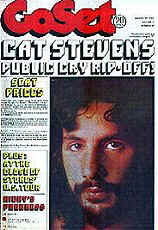Go-Set
Go-Set was the first Australian pop music newspaper, published weekly from 2 February 1966 to 24 August 1974,[1] and was founded in Melbourne by Phillip Frazer, Peter Raphael and Tony Schauble.
[2][4] In 1964, Monash University student newspaper Chaos' co-editors, John Blakeley, Damien Broderick and Tony Schauble, renamed the paper Lot's Wife.
[2] The first edition of Go-Set, dated 2 February 1966, was published with Schauble cited as editor because Frazer, a medical student, asked to be listed in the low-key role of designer and Panther, who had not registered for the military draft, was described as a feature writer.
[2] The first issue showcased Tom Jones (see right) and Herman's Hermits interviewed by Panther and photographed by Colin Beard at Palais Theatre, St Kilda.
Key staff included Tony Schauble as editor then manager, Phillip Frazer, who had switched to an arts degree at Monash, as co-editor, and Colin Beard as photographer.
Doug Panther continued as feature writer for several months before leaving for Western Australia with Commonwealth Police and the Australian Army searching for him as a 'draft dodger'.
Other personnel were Honey Lea, originally a typist, who later became fashion editor when Prue Acton dropped out, and Sue Flett who wrote an advice column under the name Leslie Pixie.
[2] Frazer urged Meldrum to join week day, TV show Kommotion on Channel 0 as a mimer[vague] so that Go-Set could get more inside stories.
[3] A key element in the early success of the newspaper was the centre page spread called "The Scene-The Seen", a weekly pictorial survey photographed by Beard in Melbourne and Grant Mudford in Sydney around the discos and dance halls.
These were its original target audience - the thousands of teenagers, especially girls, caught up in the excitement of the swinging sixties, following their favourite local Rock group around the suburban dancehalls of Melbourne.
Over its nine-year history there were many significant additional contributors including David Elfick, Alex Pezzoni, Vince Lovegrove, Ed Nimmervoll, Stan Rofe,[citation needed] Stephen MacLean,[8] Wendy Saddington, Michele O'Driscoll (aka Mitch), Cleo Calvo (now singer, Clelia Adams), Eril Bilson, Philip Morris (photographer), Ian McCausland (graphics), Jon Hawkes (editor), Geoff Pendlebury (graphics), Geoff Watson (management) and his off-sider Margaret Rose Dunphy on bookkeeping and classifieds, Helen Hooper, Jean Bedford, and Pat Wilson who wrote under the pen-name of "Mummy Cool" (1971–1972).
[citation needed] Maree Menzel wrote quirky pages covering fashion and accessories, and often modelled for the illustrations as well, photographed by Ray Strong.
Meldrum became editor of a monthly Go-Set offshoot, Gas, which was aimed at younger teen girls and was first published in October 1968 with a feature on The Monkees; its last issue was in March 1971.
He then wrote feature stories and record reviews, and in December 1969 began editing Go-Set's counter-culture supplement, Core, which was influenced by the US magazine Rolling Stone.

